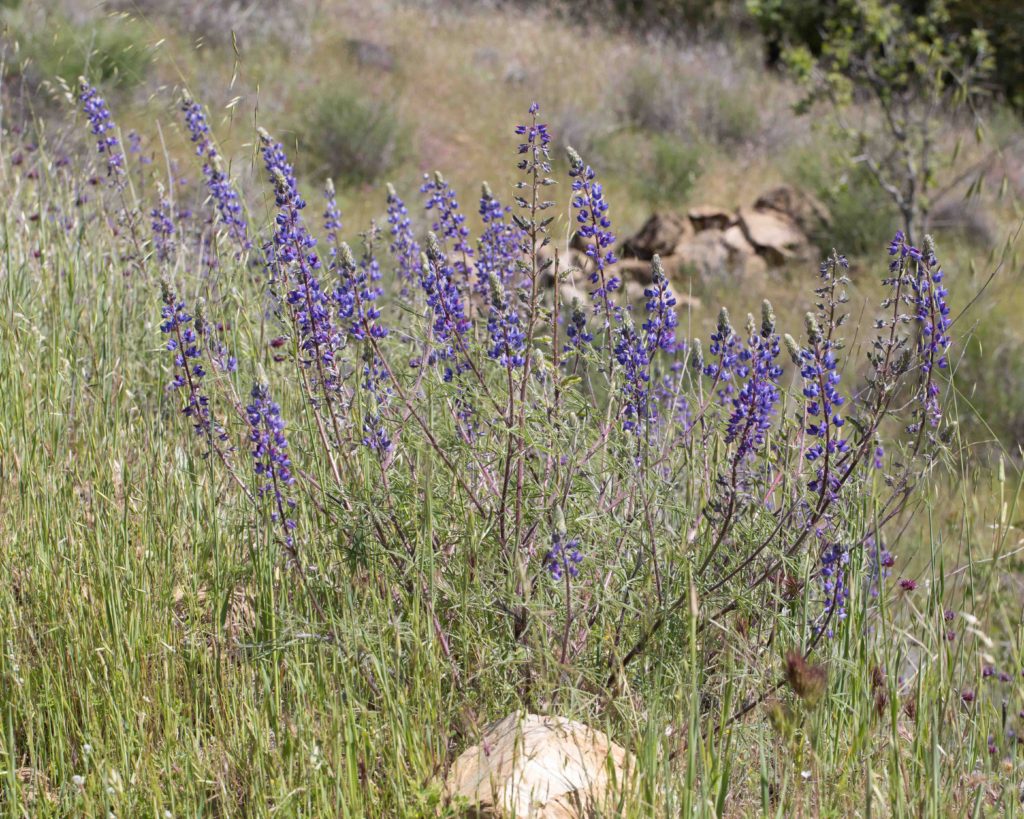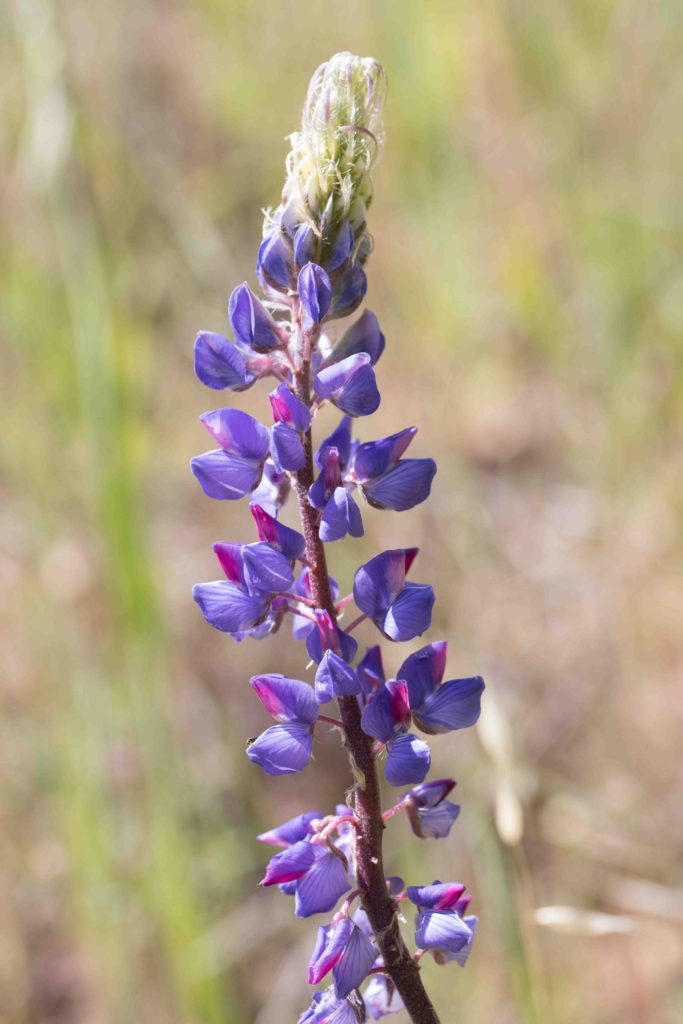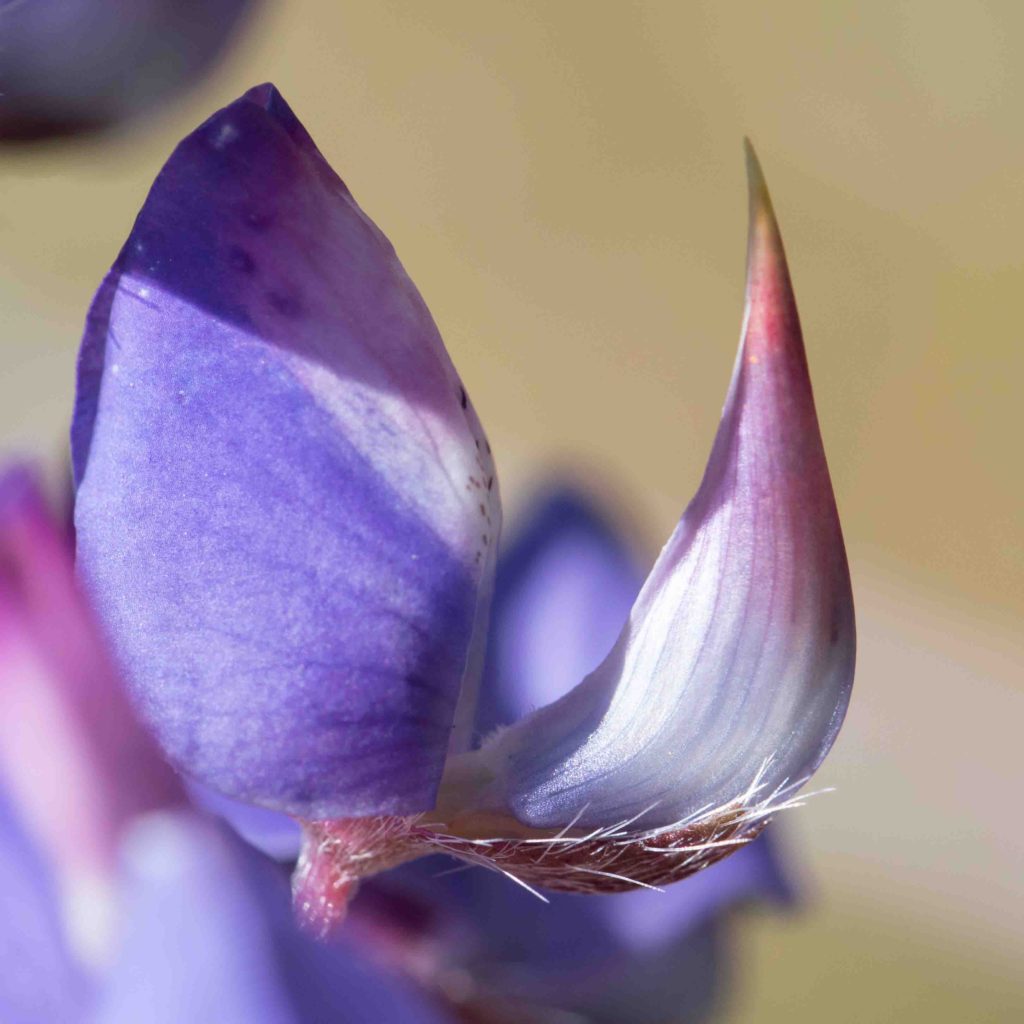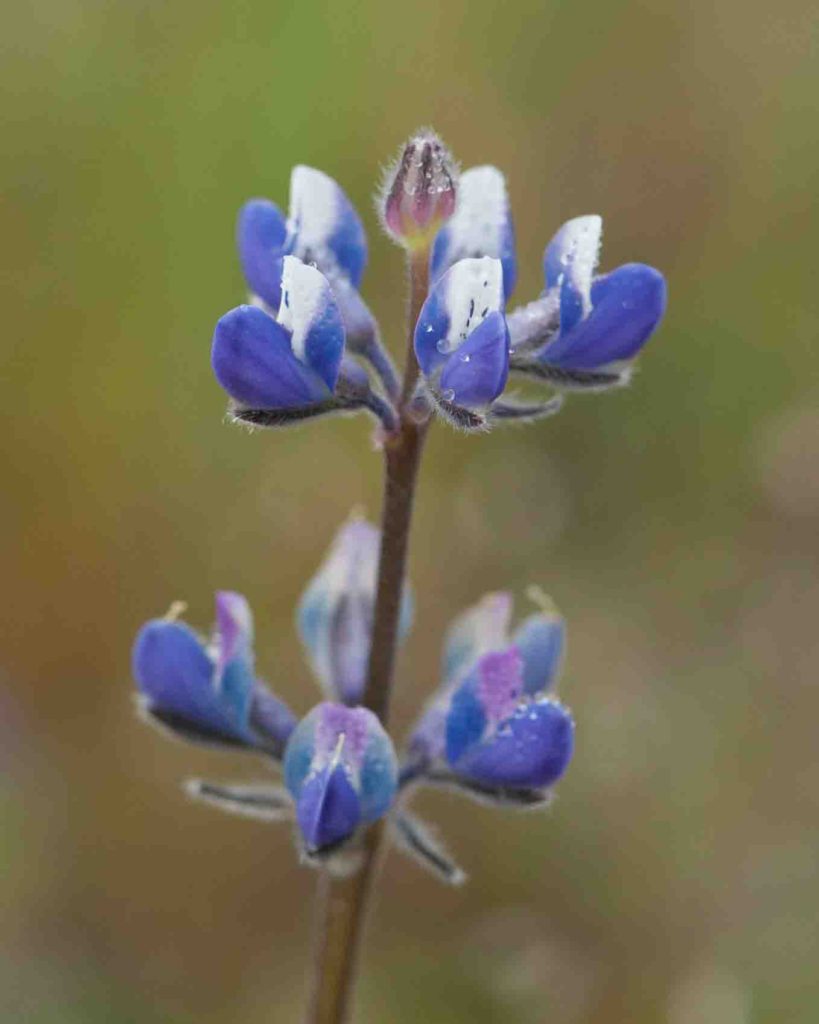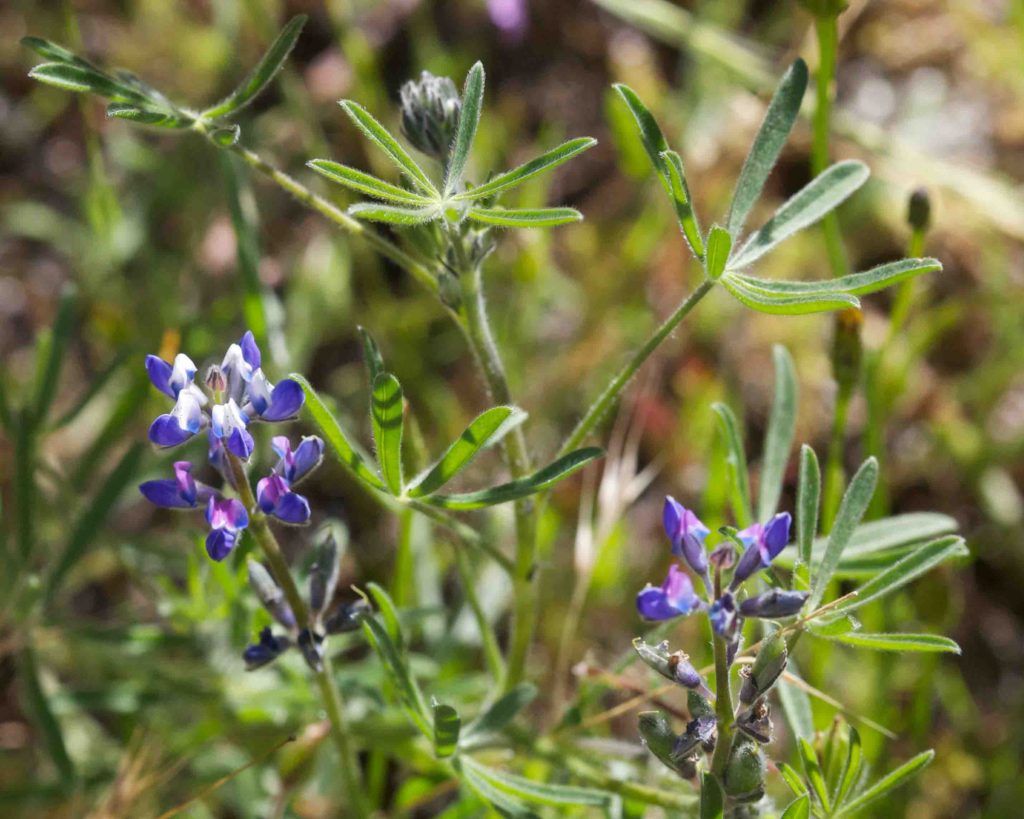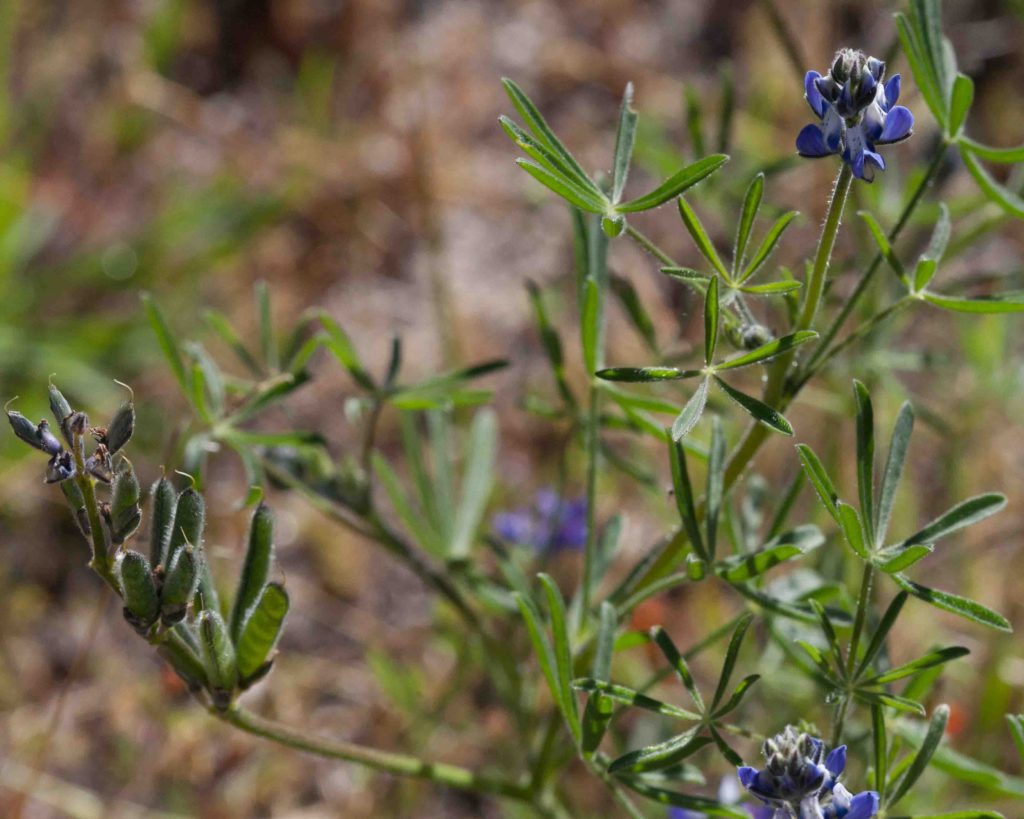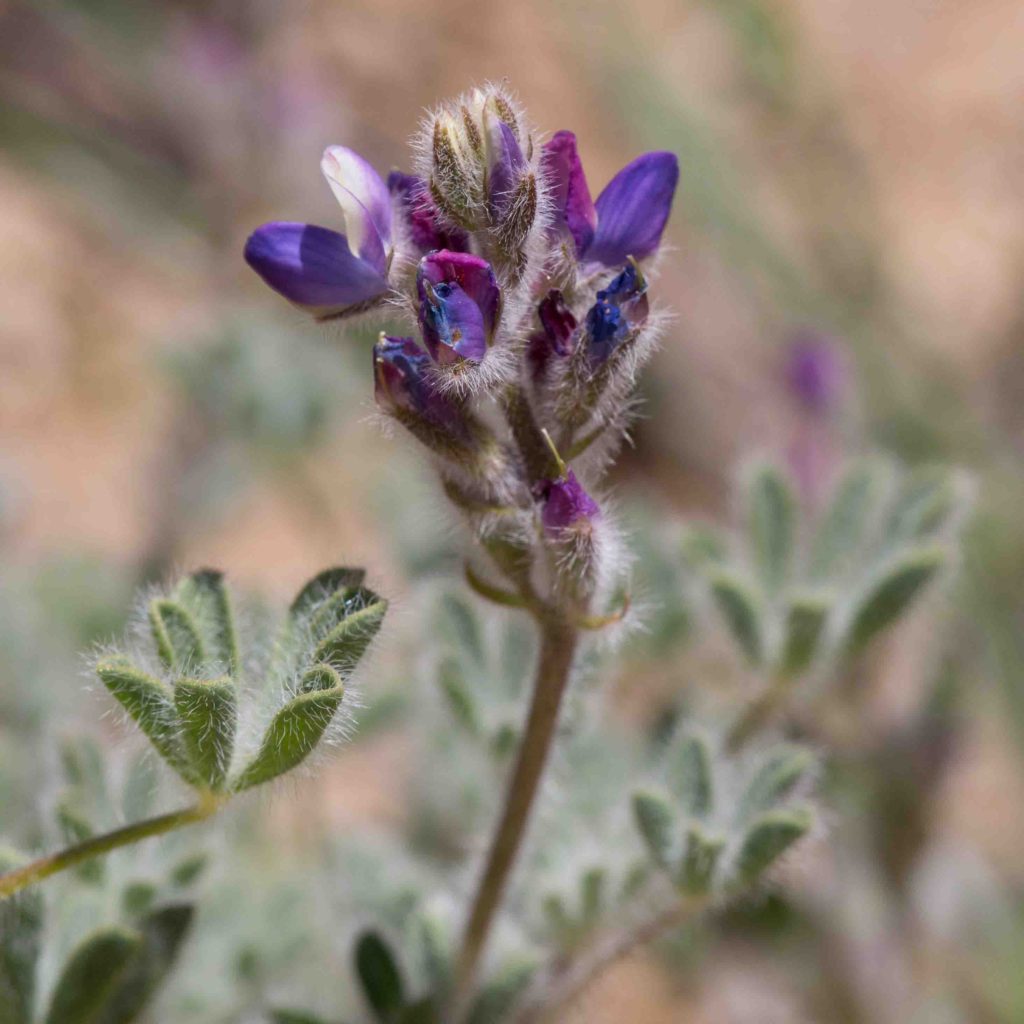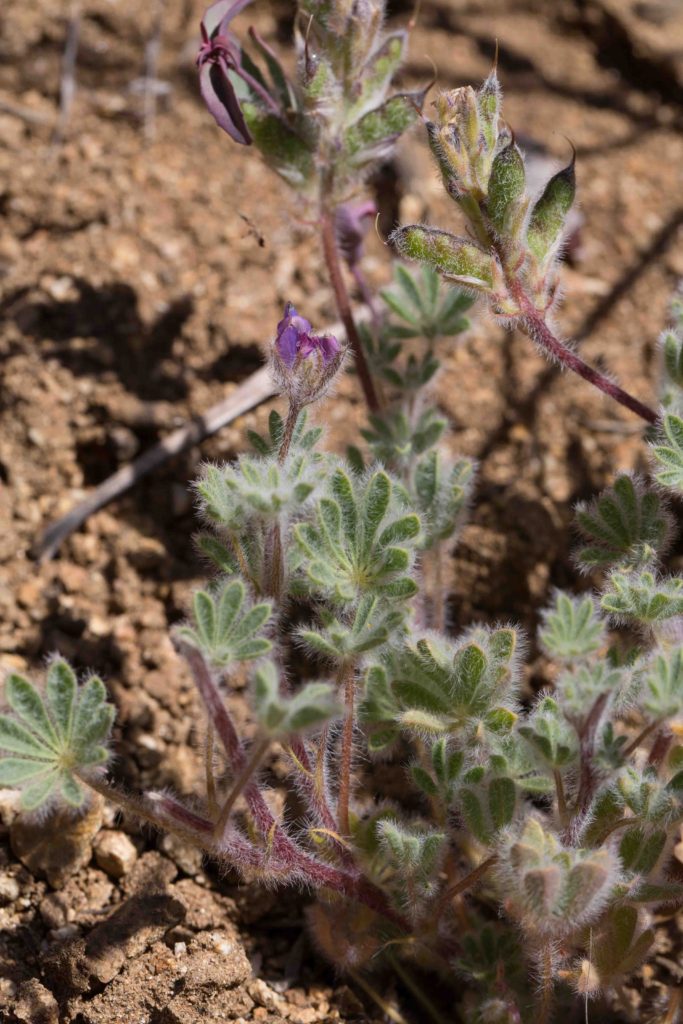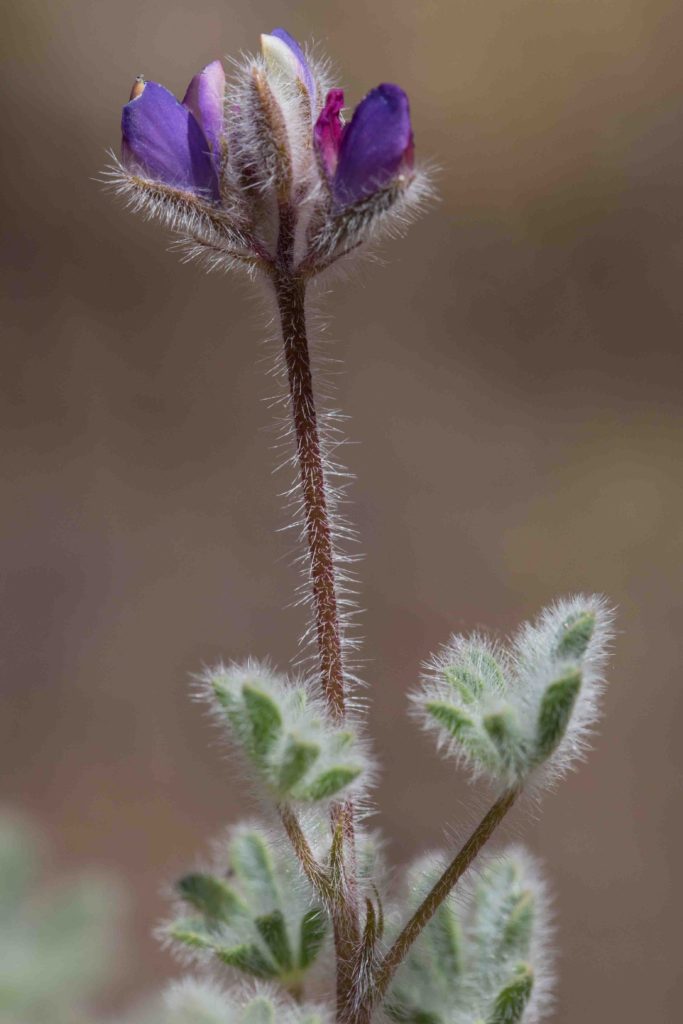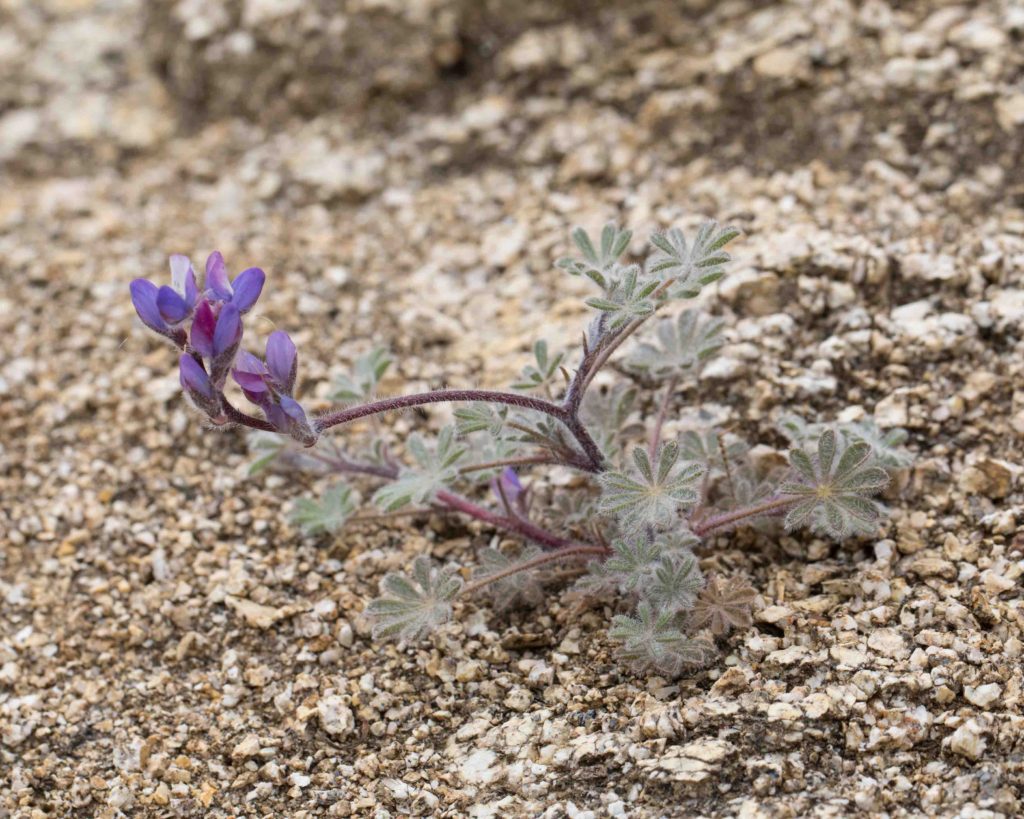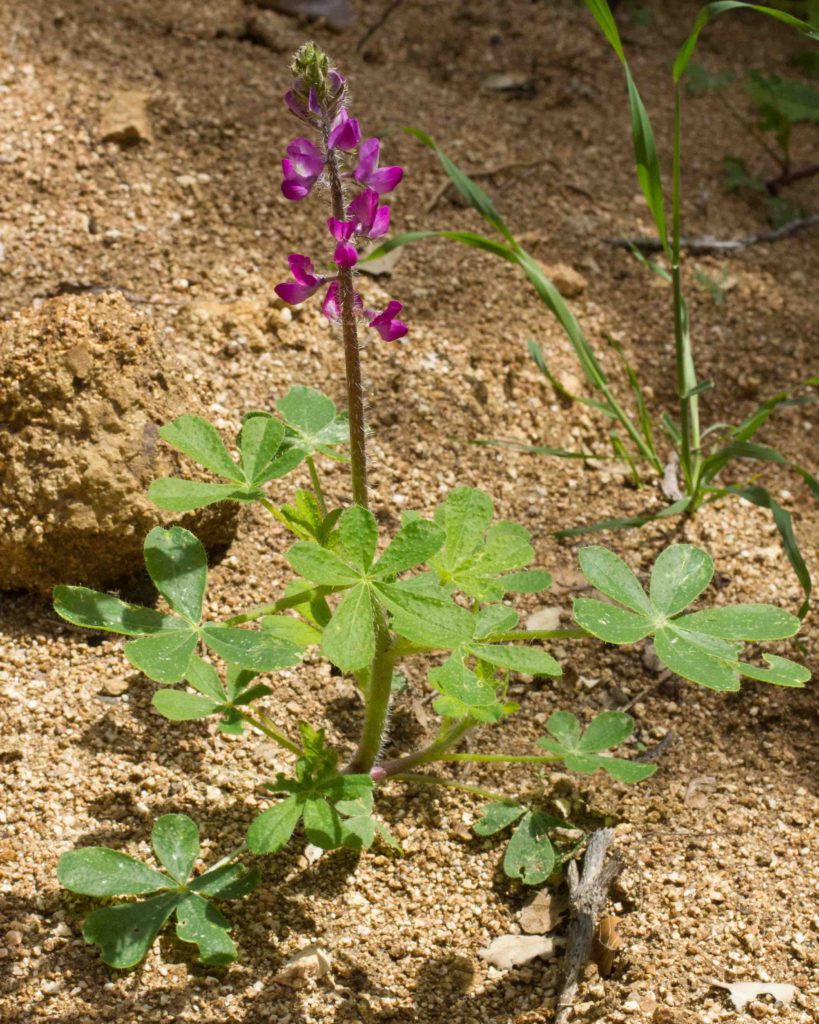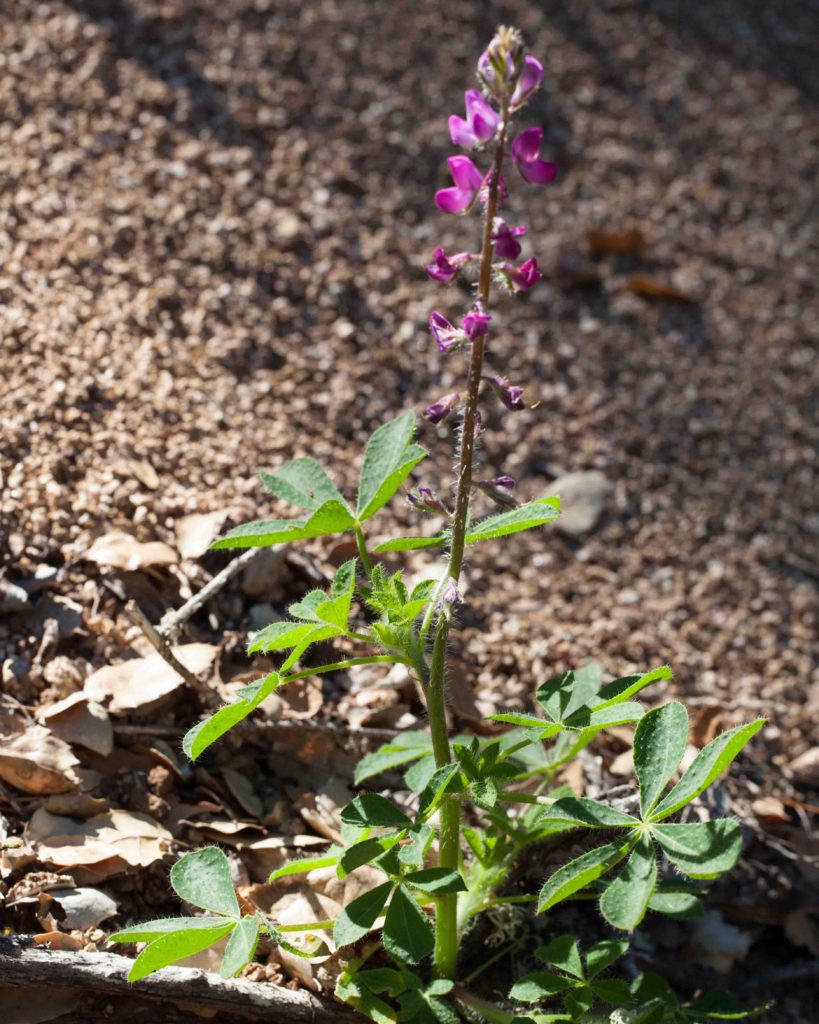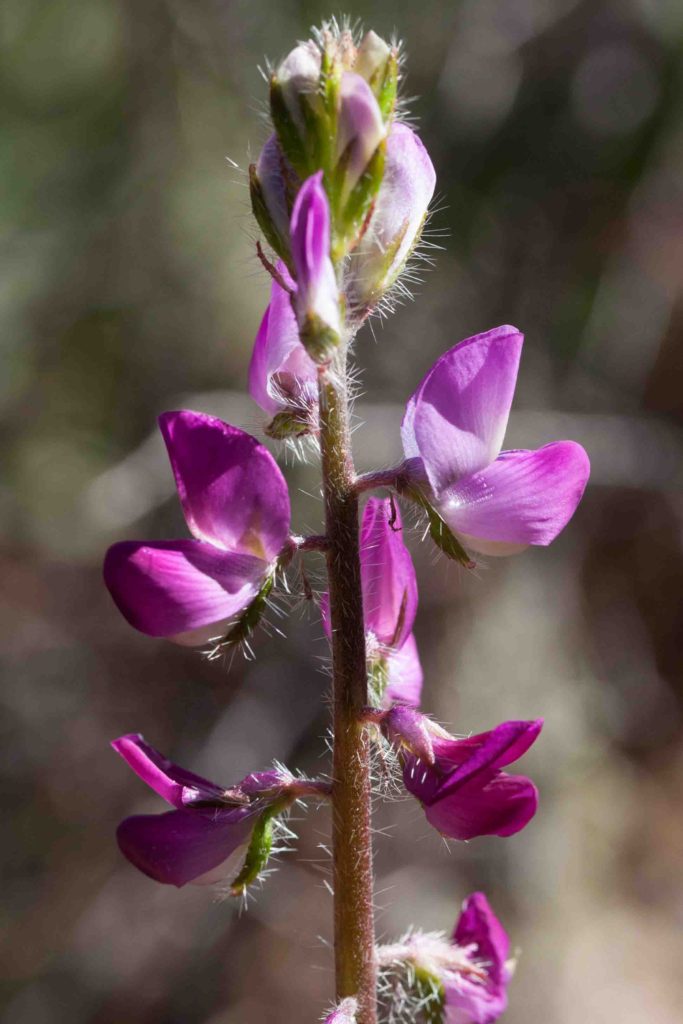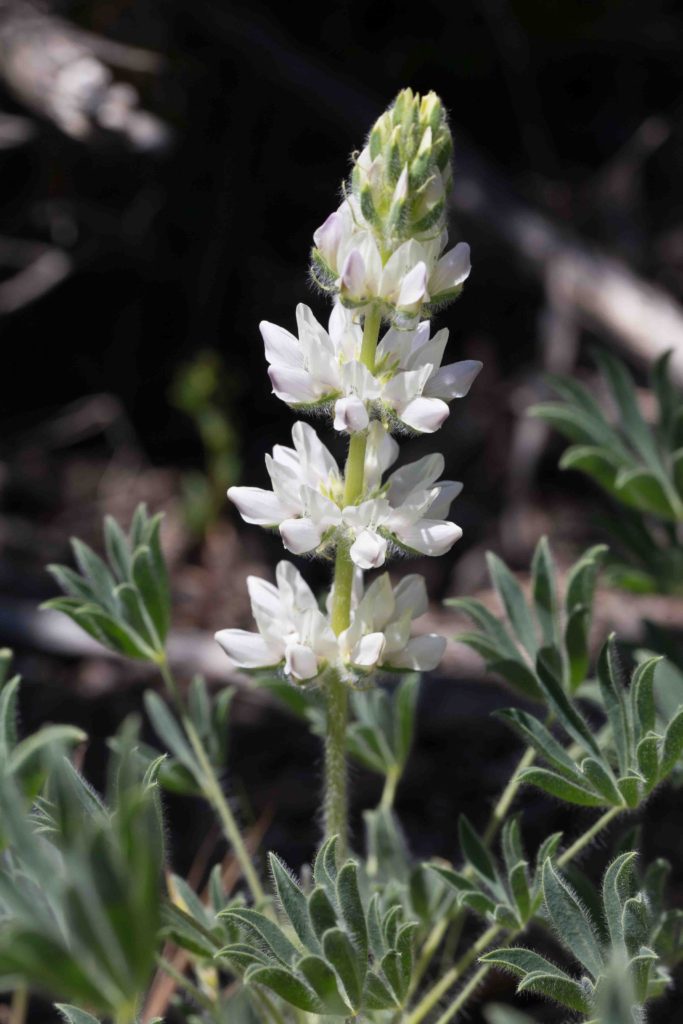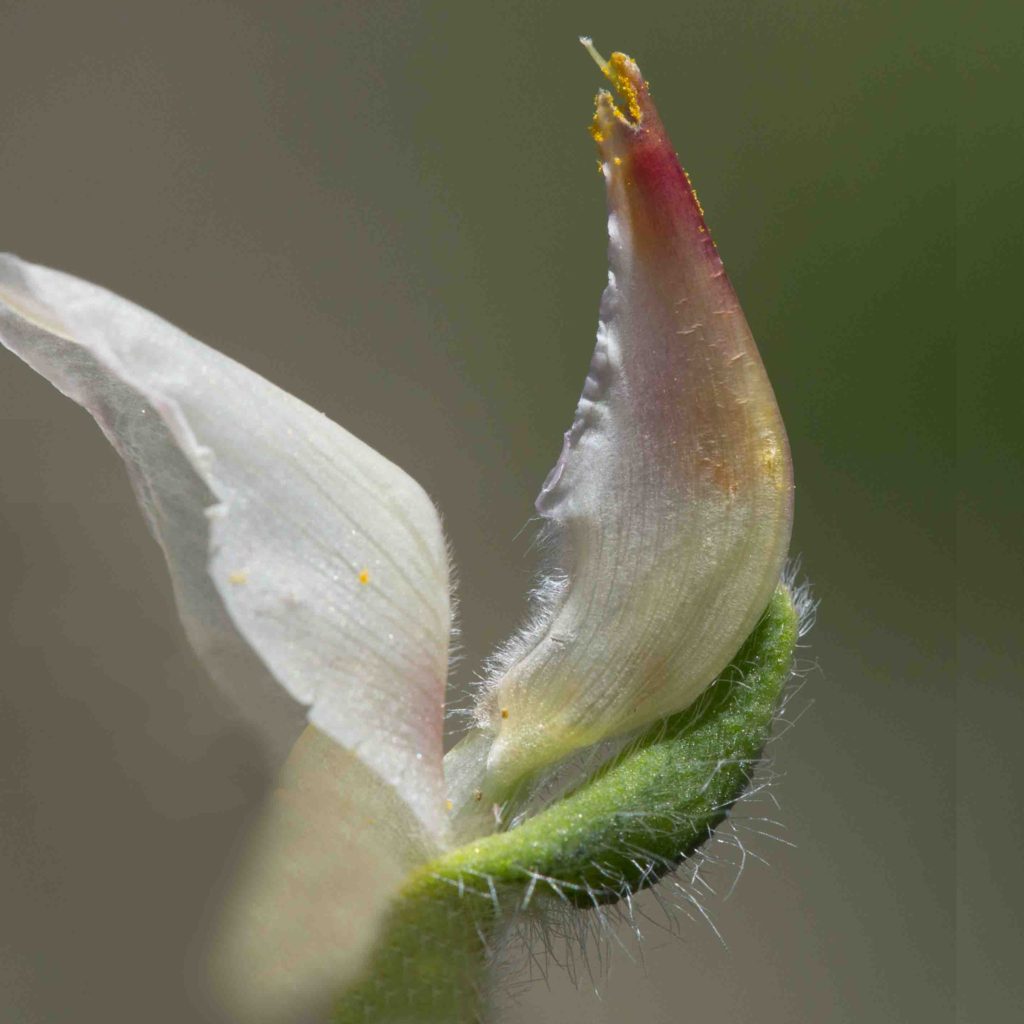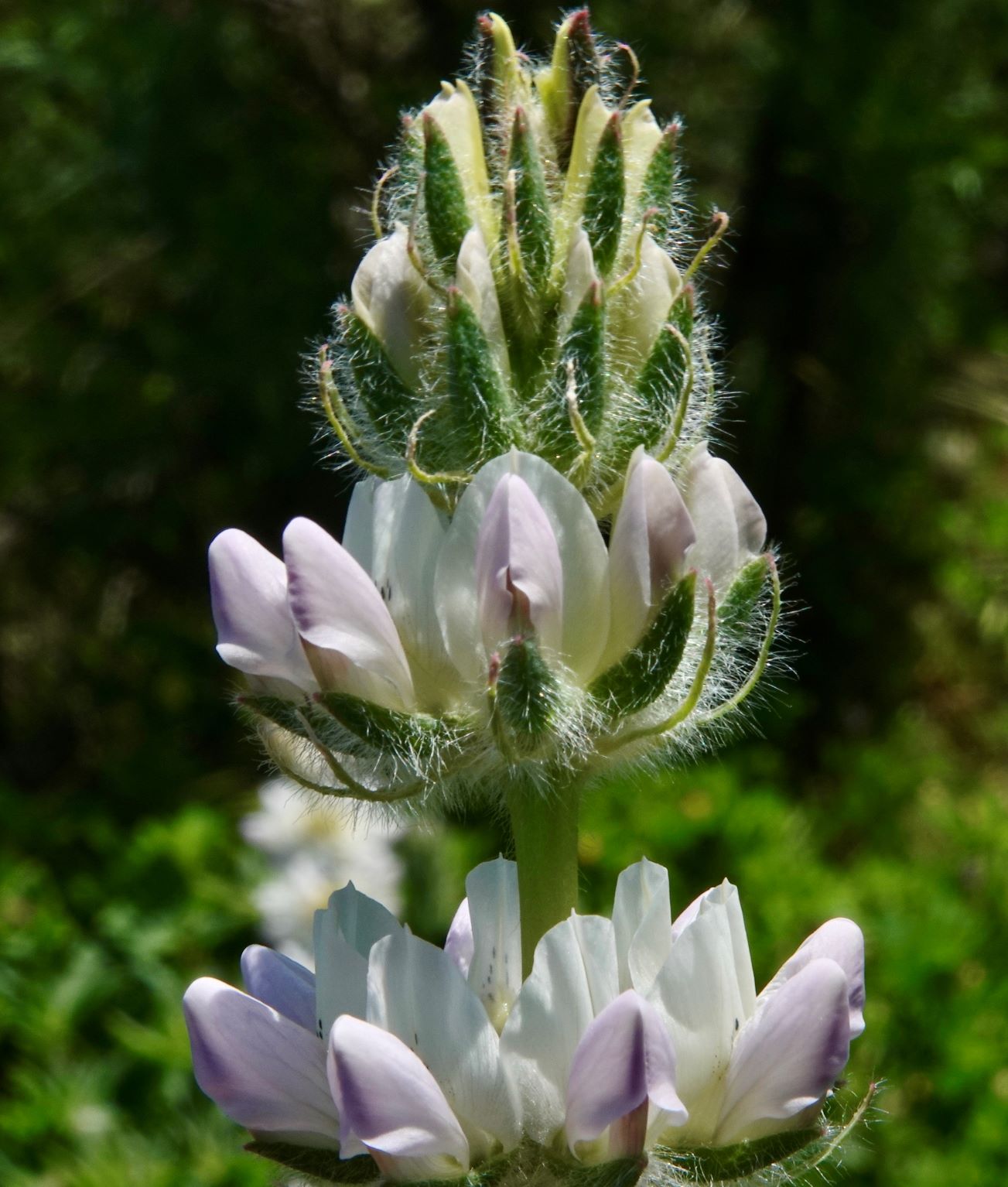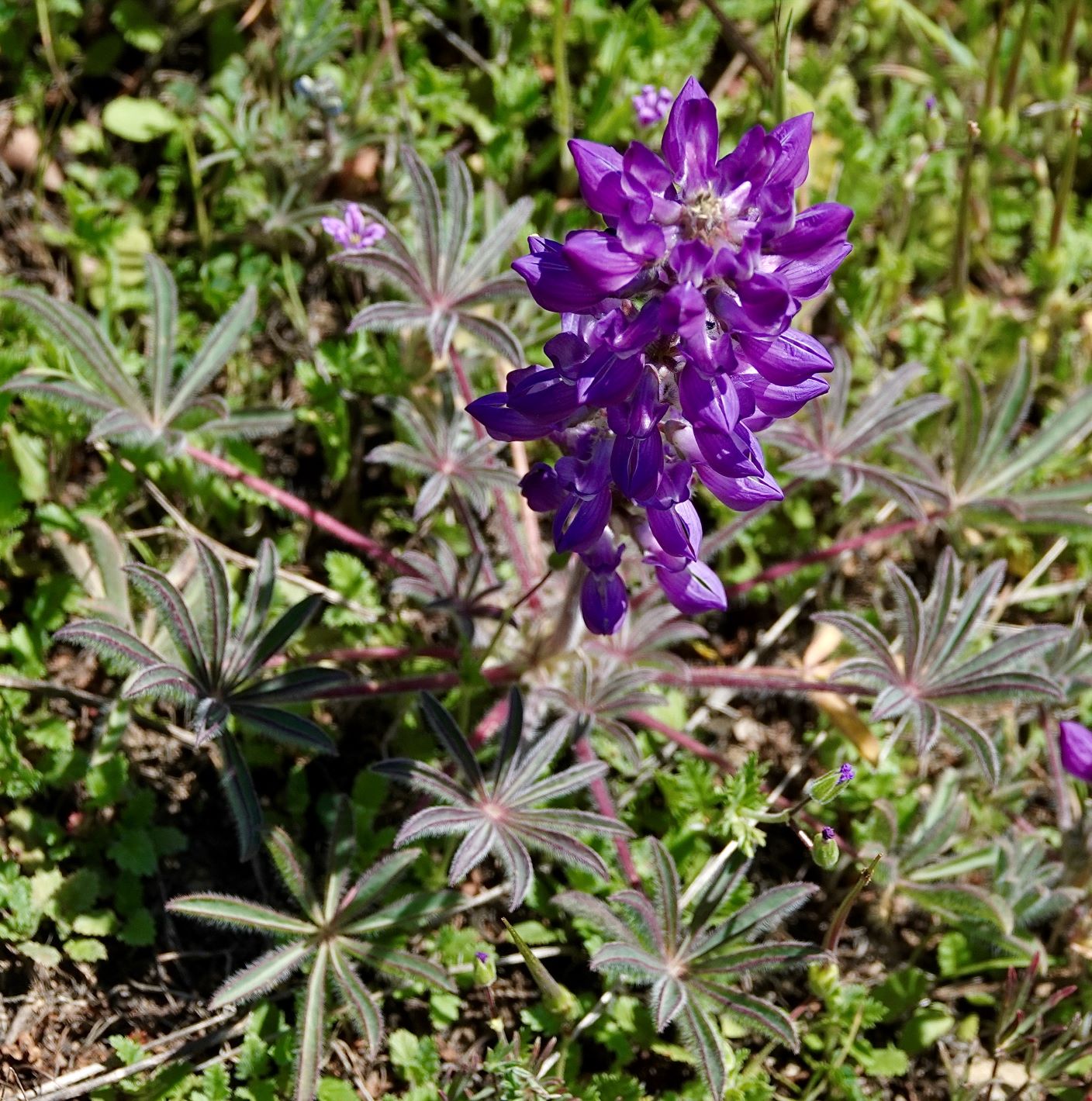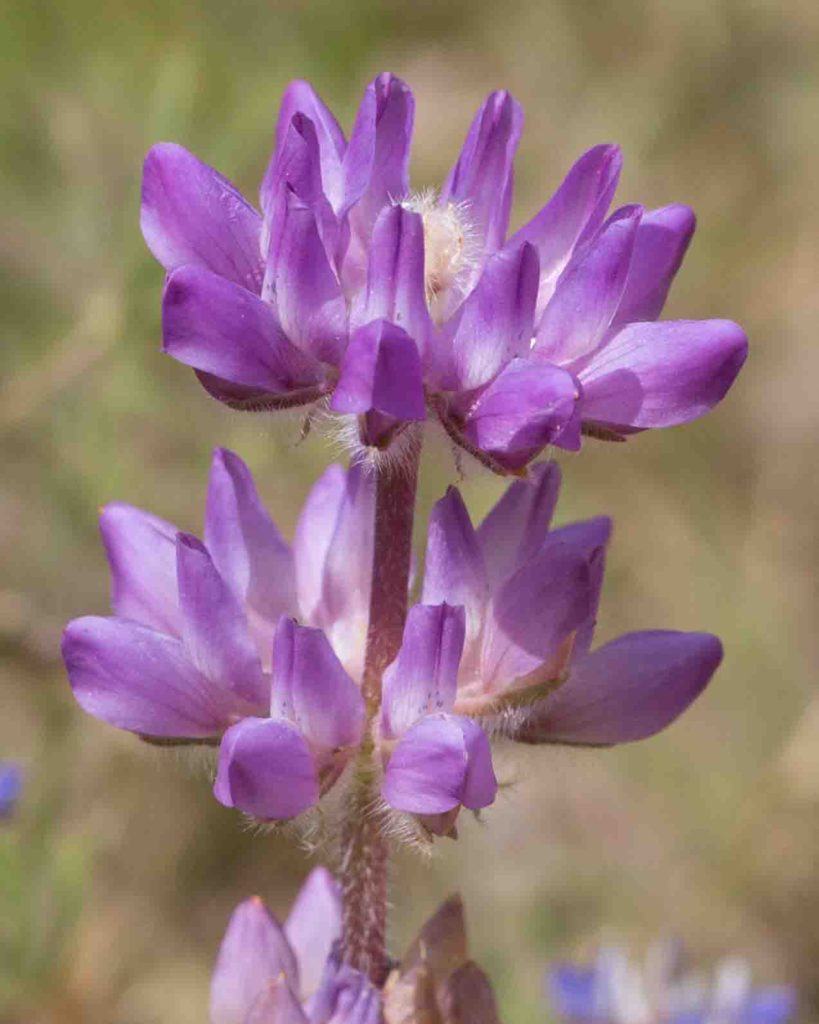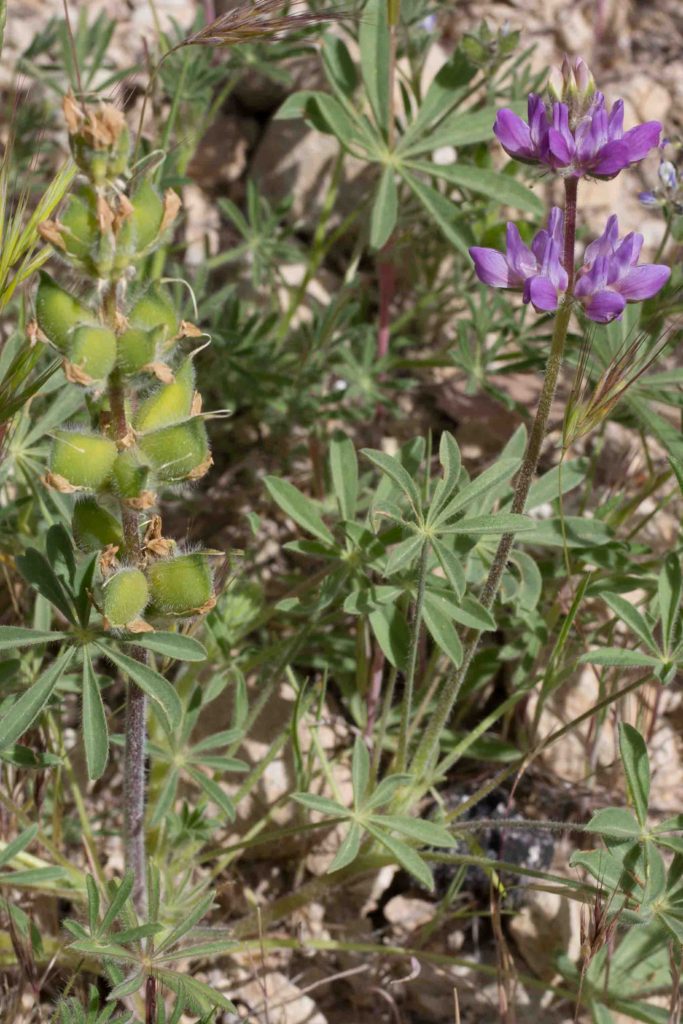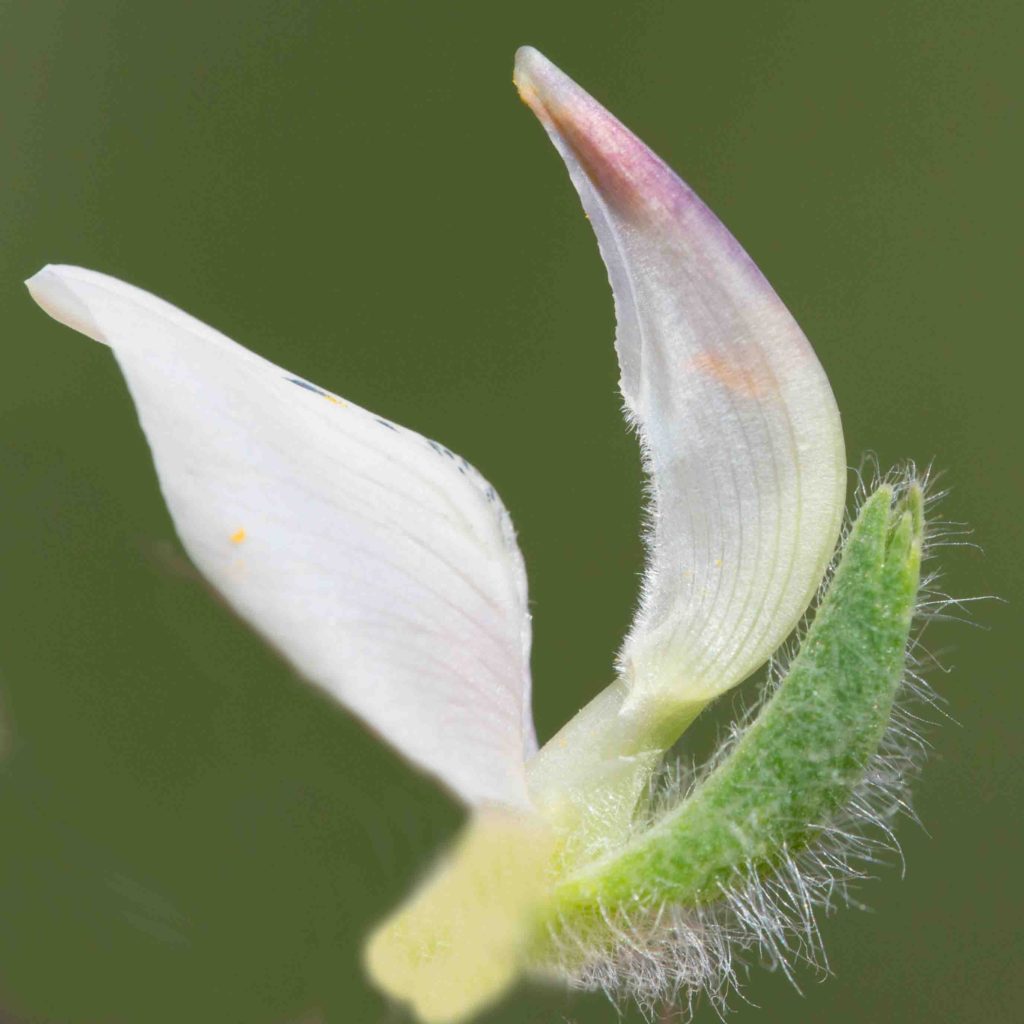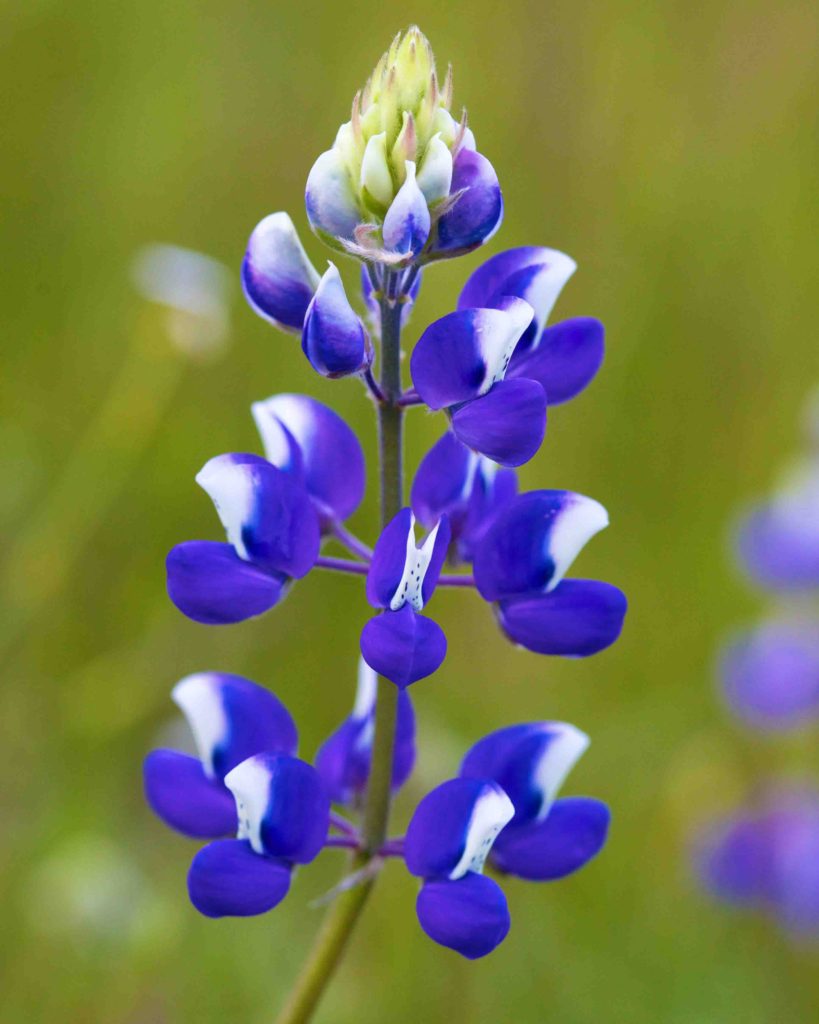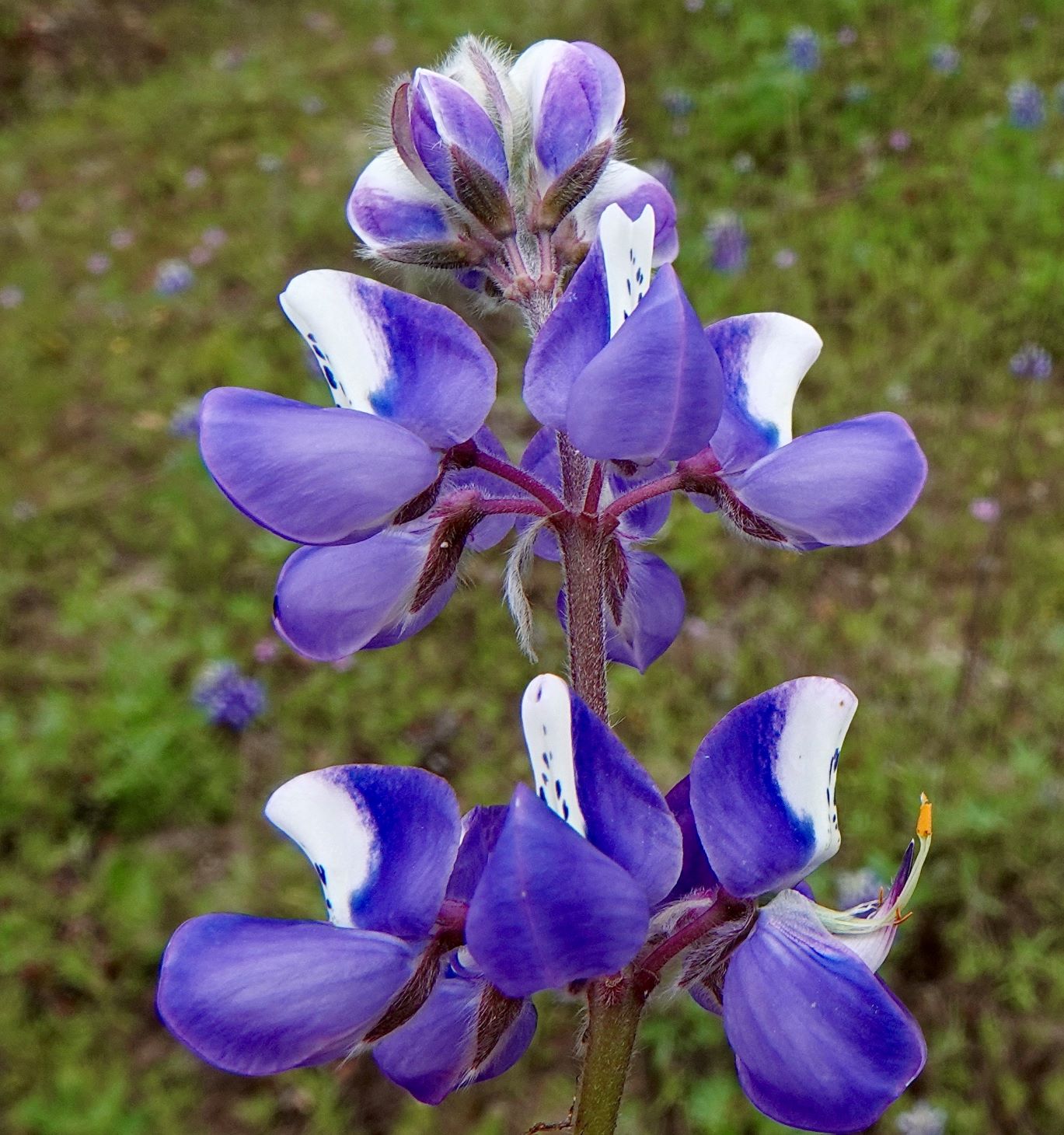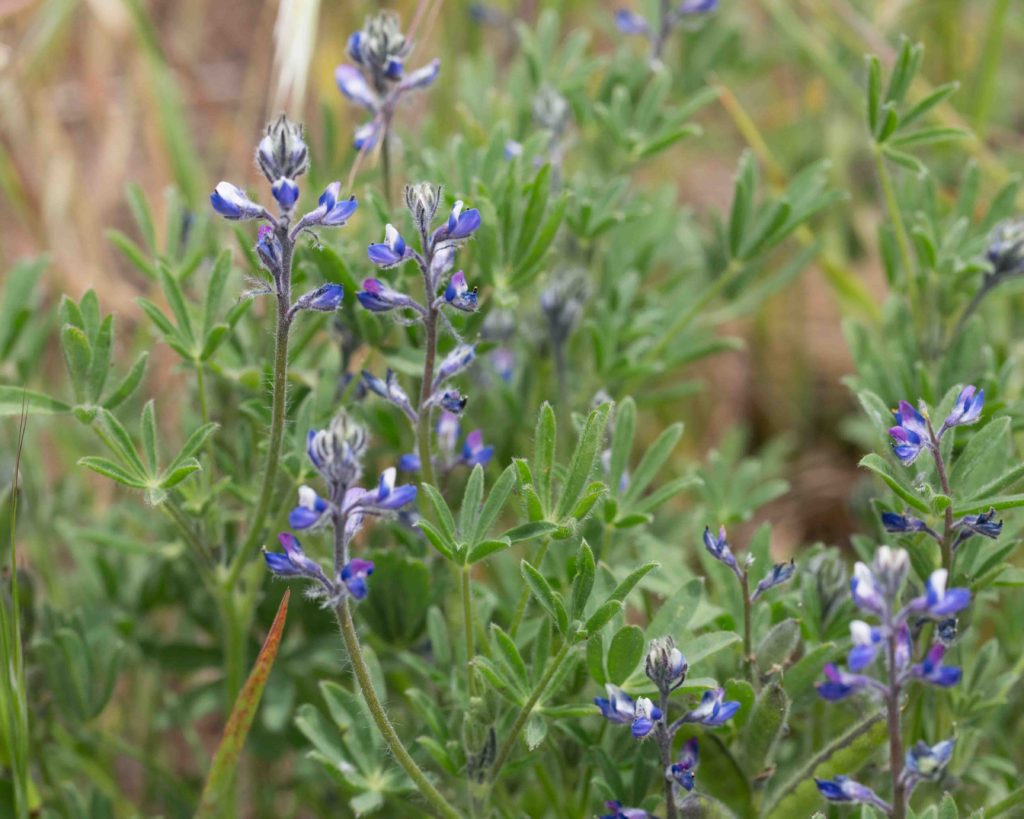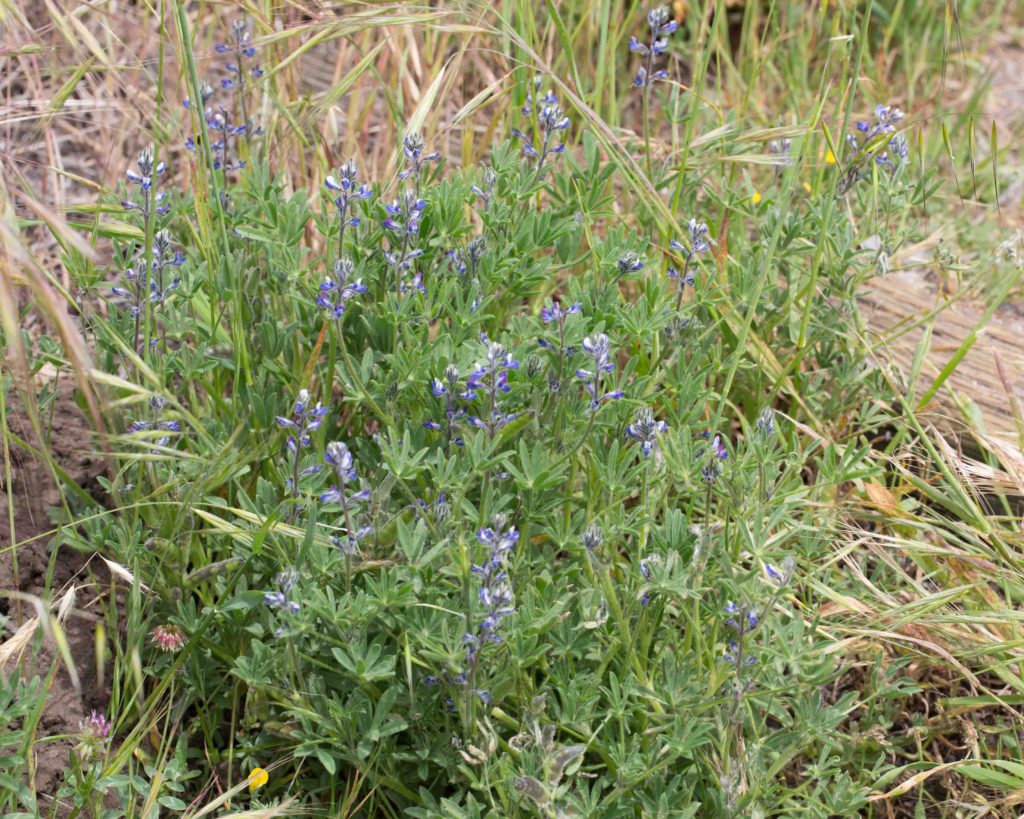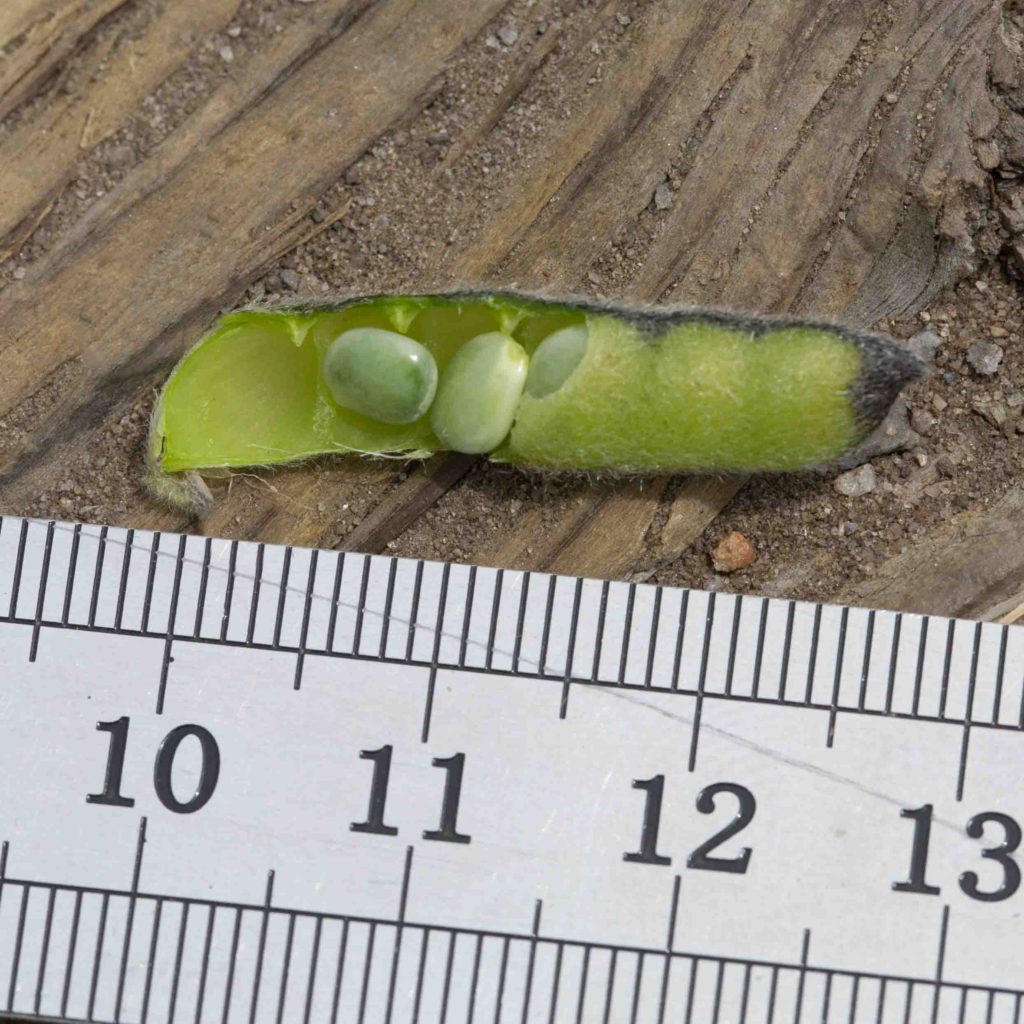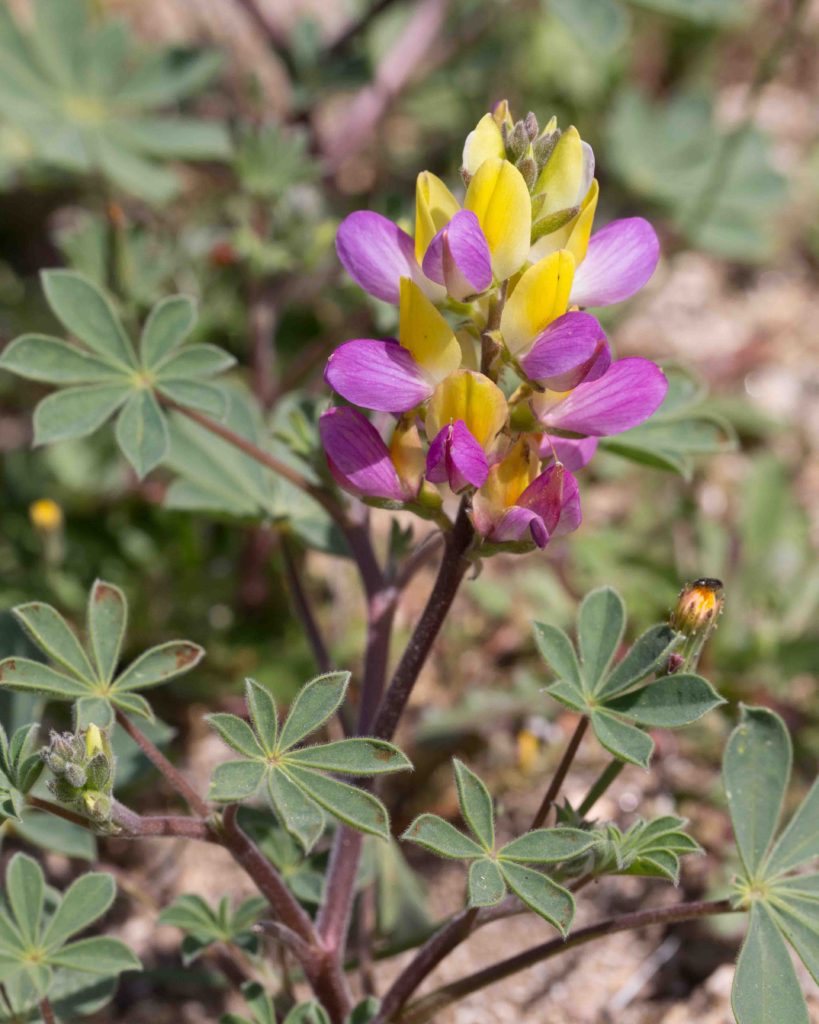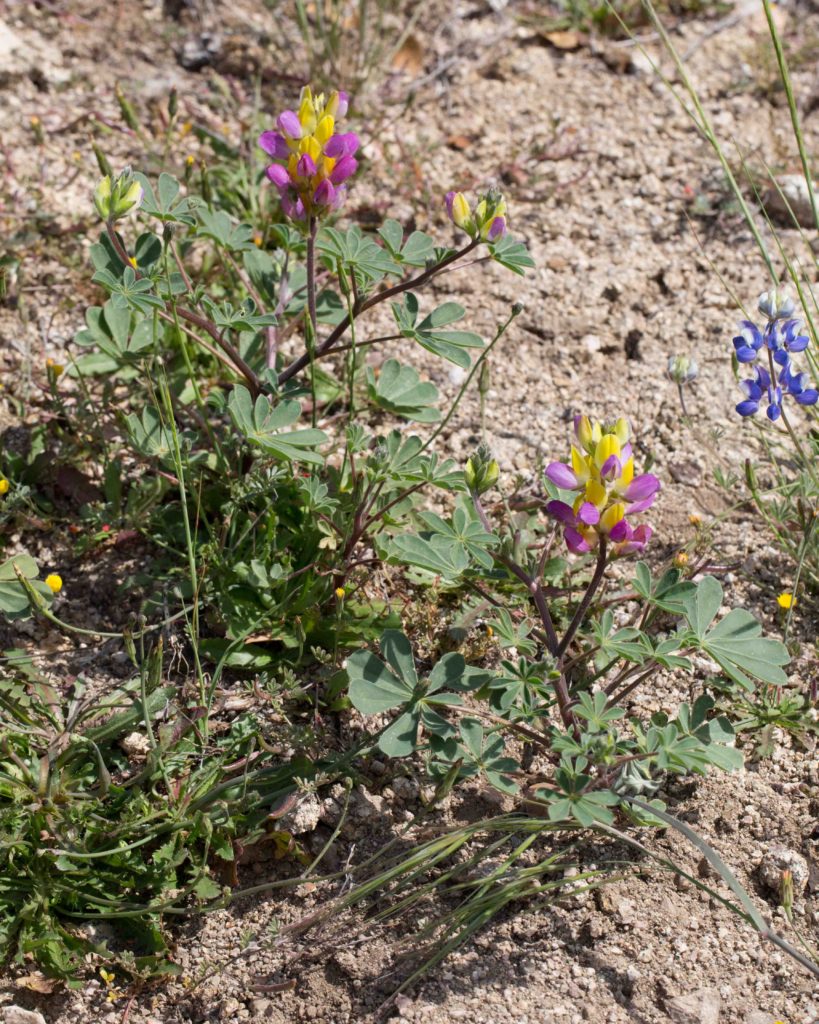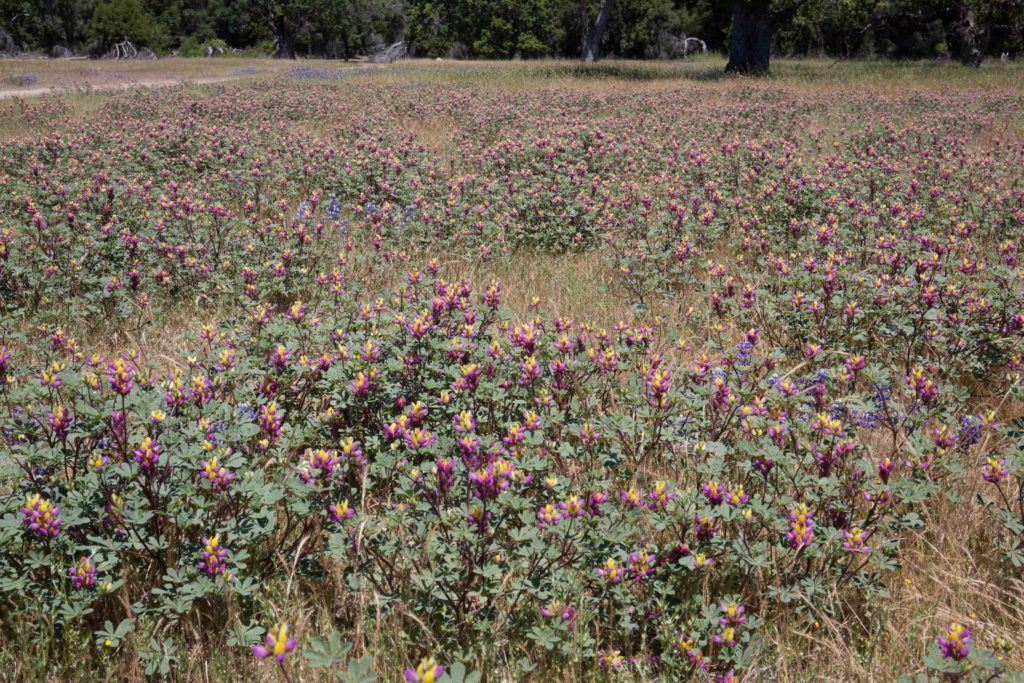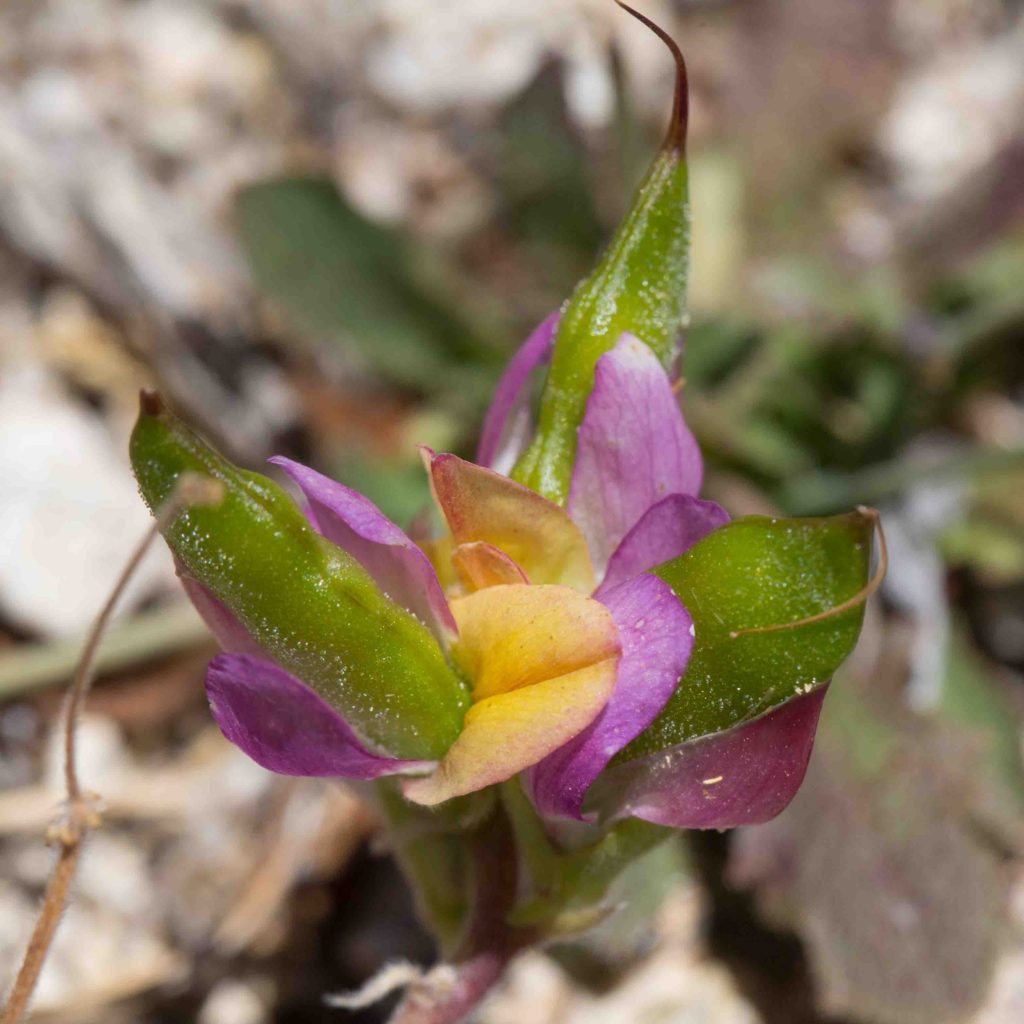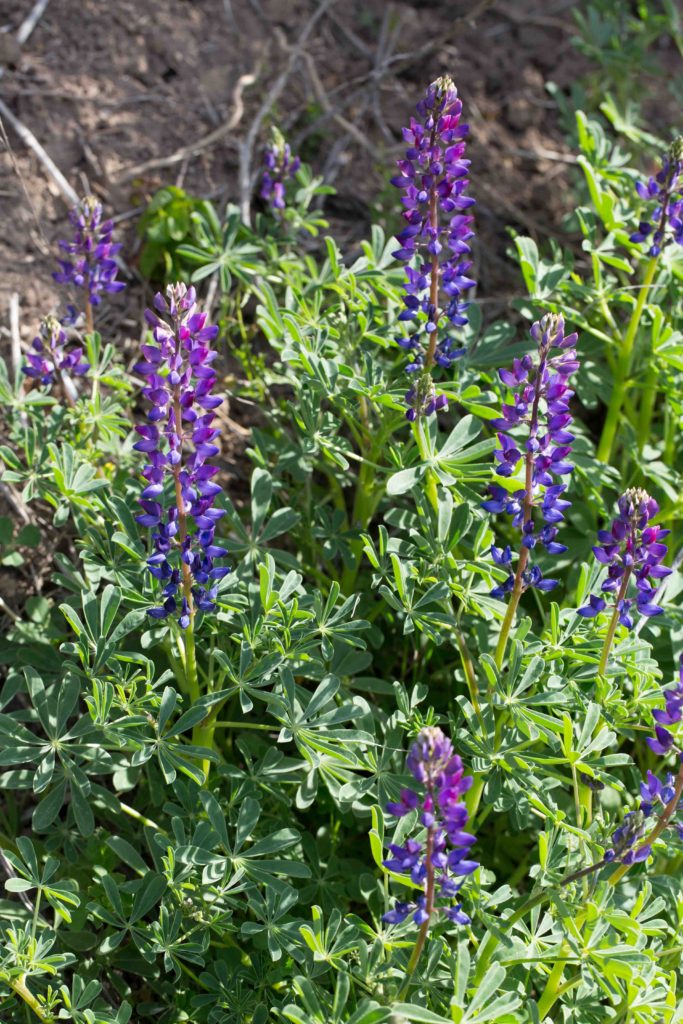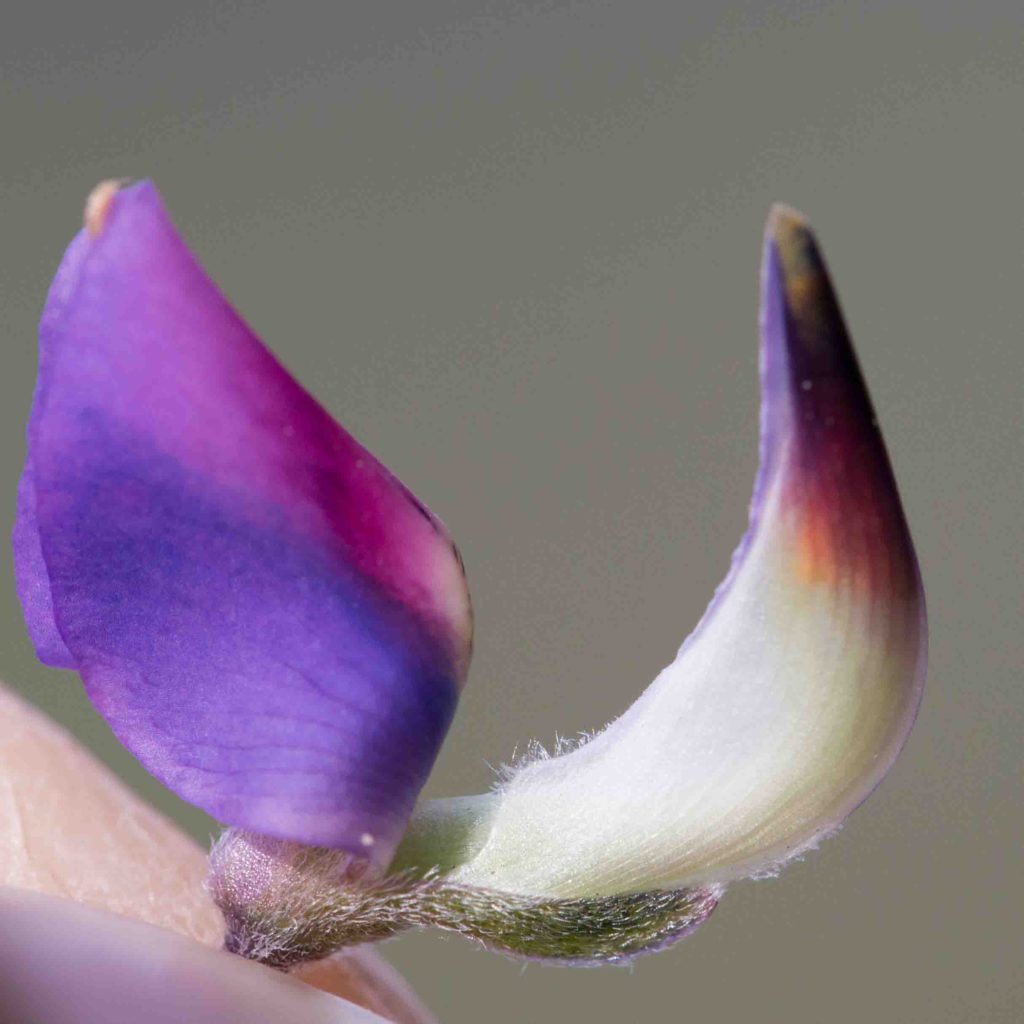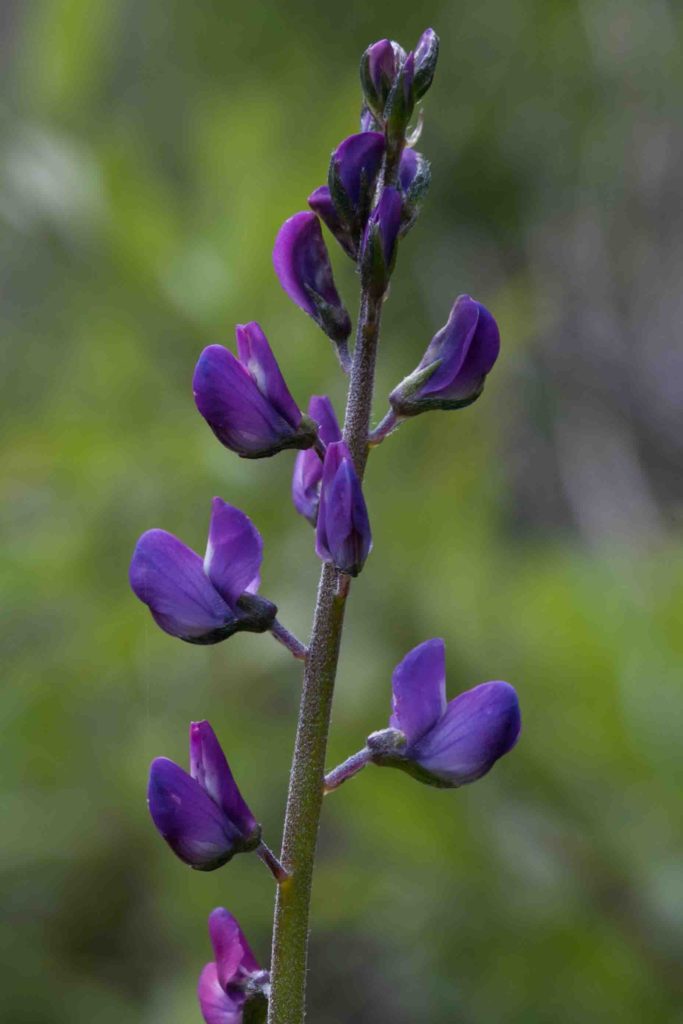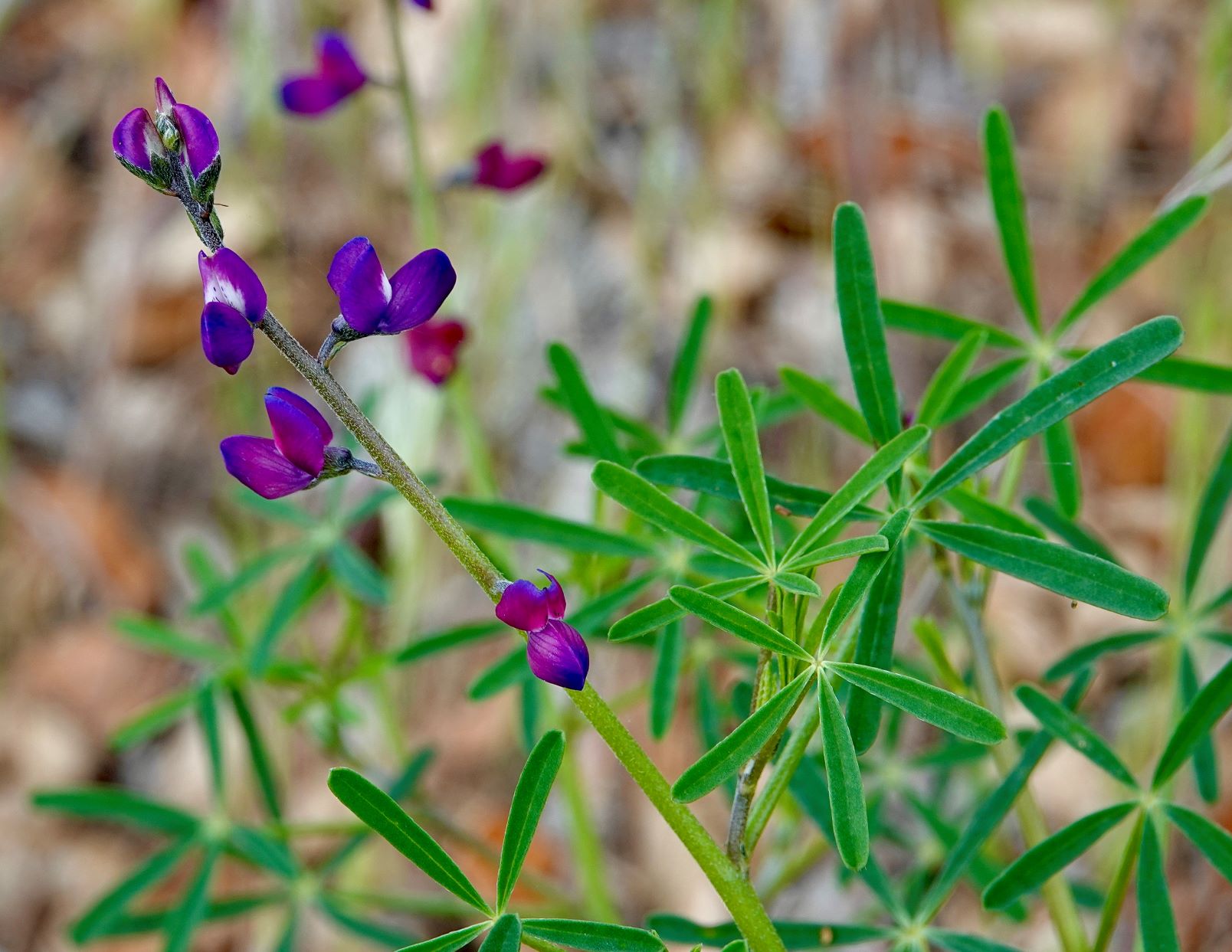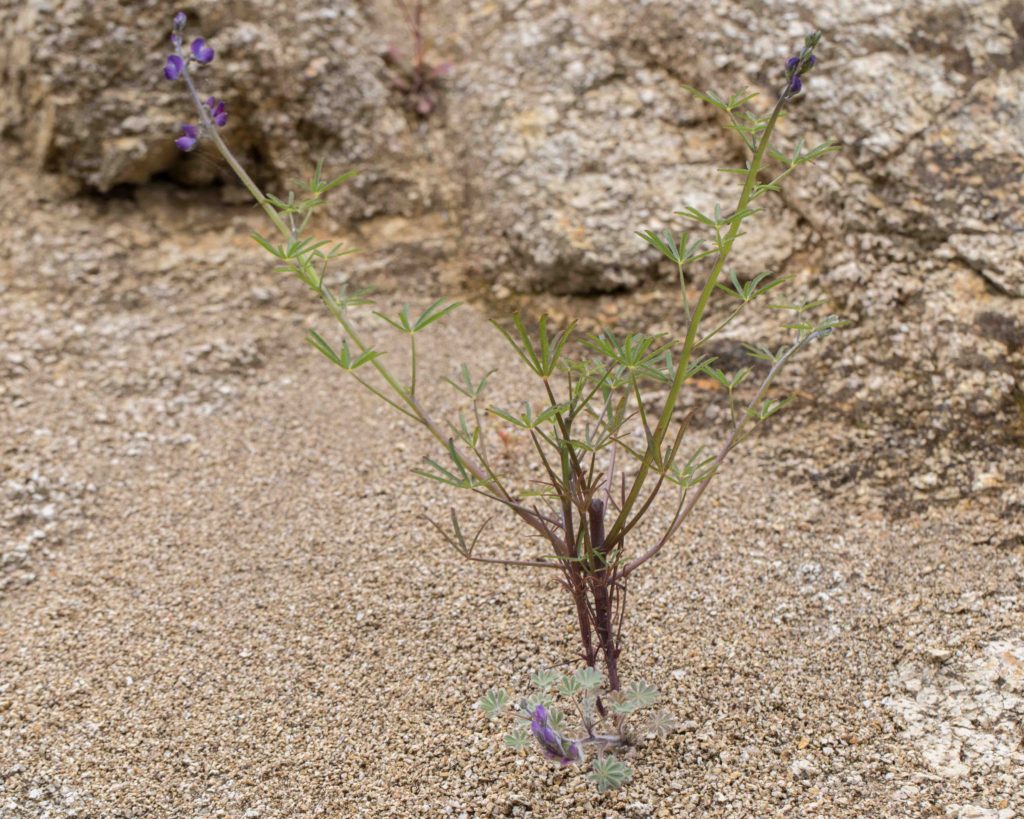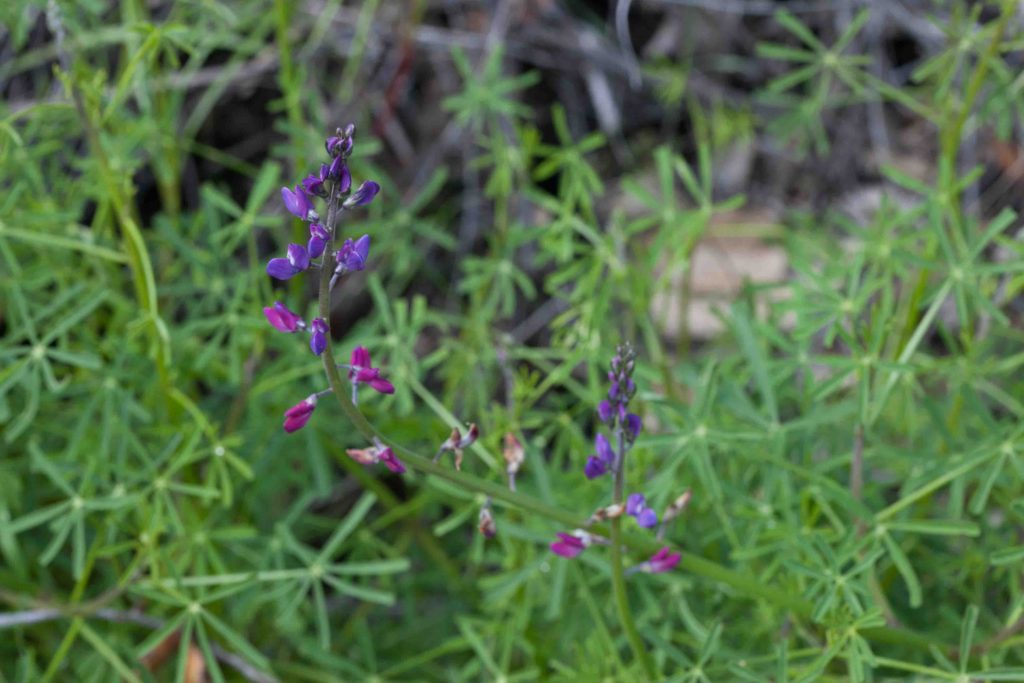Fabaceae: Pea Family — Annual Lupines
The pea family has 5-petaled flowers, consisting of a wide upper banner petal, two wing petals, plus two lower petals which are fused to form a boat-shaped keel. Many produce heads or spikes, consisting of multiple individual flowers (examples are lupines and clovers). The seed pod is generally a “legume”. This is a long, flattish pod, swollen by the seeds, and splitting lengthwise along both the top and bottom.
Most lupines have distinct clusters of flowers in spikes, sometimes short, sometimes quite tall. Leaves are typically palmately compound, with leaflets ranging from very narrow to broad. It is useful to note whether the flowers are in whorls around the stem. It can also be critical to look at the keel, to see the pattern of hairs. Some are ciliate on both the top and bottom of the keel; some have hairs only near the claw (base), others only near the tip. Photographs of some keels appear below.
Spider Lupine / Bentham’s Annual Lupine – Lupinus benthamii
Blooms:
Mar–May
Plant Height:
20–70 cm
Flower Size:
Large cluster
Origin:
Native
Habitat:
Rocky slopes, open areas, outer coast ranges
Notes:
Found only in the southern parts of the outer coast ranges. This is common along the Nacimiento-Fergusson Road, just west of Fort Hunter Liggett. It looks at first sight like a bush lupine, but is in fact an annual. It is easily identified by its tall clusters of bluish-purple flowers and the very slender, thread-like leaflets that give the plant its common name. Flowers may be whorled. Keels are ciliate along the lower margin near the claw (see last photo).
Miniature Lupine / Lindley’s Annual Lupine – Lupinus bicolor
Blooms:
Mar–June
Plant Height:
10–40 cm
Flower Size:
Medium cluster
Origin:
Native
Habitat:
Heavy soils, many communities
Notes:
A low, fairly inconspicuous plant, often growing with and sometimes confused with immature Sky Lupine (Lupinus nanus, see below). The flower clusters are smaller, and the white banner spot on the keel is taller than it is wide (the opposite of Sky Lupine), and wraps around less deeply. Flowers are whorled, with shorter pedicels toward the top. The keel is generally ciliate on the upper margin near the pointed tip. Miniature Lupine can also be confused with the much less common Big Pod Lupine (Lupinus pachylobus, see below), but the size of the fruits and seeds of the latter allow them to be distinguished without too much difficulty.
Bajada Lupine – Lupinus concinnus
Blooms:
Mar–May
Plant Height:
10–30 cm
Flower Size:
Medium cluster
Origin:
Native
Habitat:
Dry open disturbed places
Notes:
This is a small plant with decumbent to erect stems, notable for the long, spreading hairs covering its stem and leaves. Leaves have 5–9 leaflets, 1-3 cm long. The inflorescence is a dense spiral, up to 9 cm tall, of pink to purple (occasionally white) flowers. Some of the flowers appear on lower leaf axils. The banner spot is white or yellowish. The keel is generally glabrous.
Stinging Lupine – Lupinus hirsutissimus
Blooms:
Mar–May
Plant Height:
20–80 cm
Flower Size:
Large cluster
Origin:
Native
Habitat:
Open sunny, often disturbed places
Notes:
This is one of the more easily recognized lupines. It has bright pink to magenta flowers, a very hairy stem, and hairy leaves with a bumpy or blistered appearance, divided into 5–8 broad leaflets. The stems and leaf hairs can deliver an unpleasant sting, so the plant is best handled with care. The flowers are not whorled, growing on either side of the stem on short pedicels. The keel is ciliate on the lower margin, between the middle and the claw.
Chick Lupine – Lupinus microcarpus var. densiflorus
Blooms:
Apr–June
Plant Height:
10–80 cm
Flower Size:
Large cluster
Origin:
Native
Habitat:
Clay soils, common on roadsides
Notes:
This is California’s only lupine with white or cream-colored flowers. Some flowers may turn pink with age. Both calyx and bracts have sparse, appressed to spreading hairs. Fruits are concentrated on one side of the stem. The keel is ciliate on the upper margin, near the claw (see close-up photo). Photos #3-4 by CJH.
Chick / Valley Lupine – Lupinus microcarpus var. microcarpus
Blooms:
Mar–June
Plant Height:
10–80 cm
Flower Size:
Large cluster
Origin:
Native
Habitat:
Clay soils, dry places
Notes:
Although the same species as Chick Lupine (var. densiflorus, see above), this variety has several material differences. First the color of the flowers is typically pink to purple. Second, the fruits are not concentrated on one side of the stem. Third, both calyx and bracts have denser, long shaggy hairs. Photo #1 by CJH.
Sky Lupine – Lupinus nanus
Blooms:
Mar–June
Plant Height:
10–60 cm
Flower Size:
Large cluster
Origin:
Native
Habitat:
Open or disturbed areas
Notes:
The most common of the lupines in the Outer Coast Ranges, sometimes found in great profusion. The flowers are blue-purple with a purple-dotted, narrow white banner spot. As with other lupines, the spot turns reddish or violet after pollination. The keel is ciliate on the upper margin near the tip (see second photo). Photos #3-4 by CJH.
Big Pod Lupine – Lupinus pachylobus
Blooms:
Mar–May
Plant Height:
15–40 cm
Flower Size:
Small cluster
Origin:
Native
Habitat:
Grassy slopes
Notes:
Similar to Miniature Lupine (Lupinus bicolor, see above), this can be distinguished by its fruits. They are densely hairy, and large, 3 cm long and 6–9 mm wide (as against 1–3 cm long and 3–6 mm wide for Miniature Lupine). Seeds also are larger, 4–5 mm long (twice the size of Miniature Lupine’s). See the last photo for pod and seed size. The keel is blunt and glabrous.
Harlequin Lupine – Lupinus stiversii
Blooms:
Apr–June
Plant Height:
10–50 cm
Flower Size:
Medium cluster
Origin:
Native
Habitat:
Above 550 m in gravelly or sandy areas
Notes:
Uncommon but unmistakable. It has a 3–8 cm tall, multi-colored inflorescence with a yellow banner, rose to purple wings and whitish keel. The keel is ciliate on both margins, from the middle to the claw.
Arroyo Lupine – Lupinus succulentus
Blooms:
Feb–May
Plant Height:
20–100 cm
Flower Size:
Large cluster
Origin:
Native
Habitat:
Grassy flats & slopes
Notes:
Like Broad-leaved Lupine (Lupinus latifolius), this has broad leaves, but leaflets are fewer (6–9) and smaller (2–6 cm). In addition, it is a smaller plant, and its inflorescence is both shorter (< 15 cm), much deeper purple and less open. The banner is yellowish-white, turning magenta after pollination. The keel is ciliate on both margins near the claw (see last photo).
Nuttall’s Annual Lupine – Lupinus truncatus
Blooms:
Mar–May
Plant Height:
20–30(50) cm
Flower Size:
Large cluster
Origin:
Native
Habitat:
Openings in chaparral and woodland
Notes:
A fairly common and distinctive lupine with its slender, very open inflorescence. It has magenta to dark purple flowers, and its narrow leaflets have more or less squared-off ends. Photo #2 by CJH.

